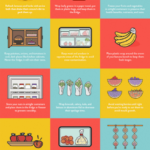Eating a healthy diet of fruits and vegetables can be pretty expensive, and not knowing how to properly store them can make it even more so. With so many people chucking a huge chunk of their fresh produce mostly due to spoilage, it comes as no surprise that billions worth of food are wasted every year.
There are plenty of ways to keep fruits and veggies fresh, and if you learn how to do it right, you might just help prevent food waste and save yourself some money.
It’s Pretty Simple, Really
Just because they’re grouped together as produce doesn’t mean they’re supposed to be tossed together into the produce drawer. While some fruits and vegetables fare better on the countertop, others keep longer when stored in the fridge. Then there are certain foods that shouldn’t be stored together at all because some give off high levels of ethylene gas that the others may be sensitive to, speed up their ripening process, and cause them to rot.
Whether you’re just picking up a few at the farmer’s market or you’re growing them in your own garden, this quick guide will help ensure your fresh produce stays fresh until meal time.
With fruits making up the bulk of ethylene producers, and vegetables being generally ethylene-sensitive, it makes perfect sense to never store them together. If you’ve been storing your apples and bananas with your eggplants and dark leafy greens, then this explains why they tend to go bad quicker.
In or Out?
Sure, it’s almost always tempting to immediately place all produce in the fridge; however, it’s imperative to know the proper spots to store them to keep them from wilting into a soggy mess. Know what goes where, and you’re all set to keep your fruits and veggies fresh and flavorful for longer.
Countertop or Pantry: Fresh produce suitable for storage on the countertop or in the pantry typically keeps for 3-7 days. Store them in a bowl or a paper/plastic bag with small holes to speed up ripening; never in a sealed bag, as the lack of oxygen increases off-odors and speeds up decay.
Some items to store include apples (that are not too ripe), bananas, potatoes, whole pineapples and melons, avocados, and stone and citrus fruits (for slow ripening, move them to the fridge).
Fridge and Cool Storage: Fresh produce suitable for storage in the fridge has different needs. While some prefer to be exposed to the air, others are best kept in airtight containers. They can be pretty picky about temperature, too, and sometimes require special care.
Some items to store include chopped fruits and veggies, ripe fruits you want to keep fresh longer, root veggies (carrots, beets, and radishes), leafy greens and herbs, berries and mushrooms, and corn.
Fruits and veggies are the most commonly wasted food items in households. The good news is, it’s nothing a bit of planning and proper storage can’t fix. Follow these proper storage tips, and you’re guaranteed to contribute in cutting food waste—all while saving money and enjoying great-tasting food all year round.





Leave a Reply